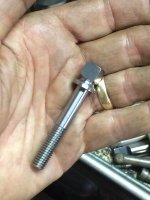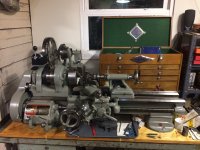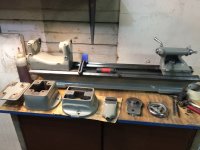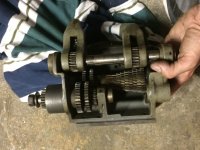Im trying to teach myself to make my own guides but seem to have run into some issues. My cuts seem to start out well but as I get closer to the chuck I start to get "ribs" in the material. I'm a complete beginner so any advice is appreciated. Thank you! 
You are using an out of date browser. It may not display this or other websites correctly.
You should upgrade or use an alternative browser.
You should upgrade or use an alternative browser.
Help with lathe
- Thread starter Sqwirl57
- Start date
Grind a HSS tool bit to the appropriate angles. A bit for aluminum will work great. You will get a great finish. I don't have time now to go to detail but there's plenty of detailed info available to you. If you don't teach yourself to use and sharpen HSS you are missing out on understanding your lathe completely. Make different profiles and practice on different materials. That's the only way to learn. Practice. That carbide you are using is pretty useless. Totally wrong profile.
A few HSS bits allow you to machine practically anything anytime. I've been doing just that for 50 years. But I had to practice first!
A few HSS bits allow you to machine practically anything anytime. I've been doing just that for 50 years. But I had to practice first!
Upvote 0
Guides are long, skinny, thin walled things that present a unique set of problems. Your best bet is to talk to someone who has made these things and find out what they did, the steps and the tooling. Maybe drilling the hole last is the best way to go in order to maximize stiffness during turning. Or maybe turning on a mandrel is the way to go.
On cutting tools, plastics generally cut best with more clearance and more rake, and don't like slow feeds. But as you saw, with enough support even a less than optimum tool can still produce a decent finish.
On cutting tools, plastics generally cut best with more clearance and more rake, and don't like slow feeds. But as you saw, with enough support even a less than optimum tool can still produce a decent finish.
Upvote 0
So do I want my tooling to be as close to the center line of whatever I'm cutting? I currently have it setup a bit below that center line.That carbide tool bit is putting to much pressure on the work, as it gets closer to the chuck the work piece cannot flex as much, bit is dragging. Best guess.
Upvote 0
The companies I’ve worked at did lots of plastic machining. If a tool, no matter what kind of cutting tool was used on metal (even soft aluminum) it would then NOT be used on plastic. Our cutting tools were literally as sharp as scalpels. One little slip near the tool and it would slice you wide open.
Looking at your initial photo, it looks like a feed rate issue.
Looking at your initial photo, it looks like a feed rate issue.
Upvote 0
On center or a little below.So do I want my tooling to be as close to the center line of whatever I'm cutting? I currently have it setup a bit below that center line.
Upvote 0
Everything KWK said is spot on.Grind a HSS tool bit to the appropriate angles. A bit for aluminum will work great. You will get a great finish. I don't have time now to go to detail but there's plenty of detailed info available to you. If you don't teach yourself to use and sharpen HSS you are missing out on understanding your lathe completely. Make different profiles and practice on different materials. That's the only way to learn. Practice. That carbide you are using is pretty useless. Totally wrong profile.
A few HSS bits allow you to machine practically anything anytime. I've been doing just that for 50 years. But I had to practice first!
Upvote 0
Ok so I'm way below. I'll adjust that ASAP and start looking for some better tooling for the job. Im going to setup the gearing for fastest chuck speeds and the slowest feed speed as well (if that sounds right?)On center or a little below.
Upvote 0
Google “Joe Pie machinist”. In your spare time (ya know, while you’re working  ) watch some of his videos. He’s a very good resource.
) watch some of his videos. He’s a very good resource.
Upvote 0
Thats just a smidgen nicer than what I have!One of my favorites in my shop. Was stored nearly unused for many years when I got it. I was the first to ever cut metal on it! The gearbox had no crud in it. Has a rare hardened bed.
View attachment 291374View attachment 291375View attachment 291376
Upvote 0
You don’t necessarily need the slowest feed speed. It just depends what the part is for. If it’s a screwdriver handle, about any finish will do. If it’s a moderator for your rifle you’ll want a nice fine smooth consistent finish. You will be the judge on what is right. Experience/experimenting will teach you how to achieve that.Ok so I'm way below. I'll adjust that ASAP and start looking for some better tooling for the job. Im going to setup the gearing for fastest chuck speeds and the slowest feed speed as well (if that sounds right?)
You can experiment with finishes on your preliminary cuts and determine if that is desirable for your finish cut.
Different plastics will cut completely different with the same cutting tool. Delrin was always good to work with. Nylon can be a challenge until you work the bugs out. Sanding a plastic finish can be frustrating. Wet sanding at a lower RPM is helpful. A dull finish can result but some Lemon Pledge or car wax can improve the shine instantly.
Upvote 0
KWK,
I used to have that exact lathe with the factory metal cabinet base. I had every attachment made for it, including ID and OD grinding attachment.
I used to have that exact lathe with the factory metal cabinet base. I had every attachment made for it, including ID and OD grinding attachment.
Upvote 0
I'm getting there. You should see how bad my first few attempts wereYou don’t necessarily need the slowest feed speed. It just depends what the part is for. If it’s a screwdriver handle, about any finish will do. If it’s a moderator for your rifle you’ll want a nice fine smooth consistent finish. You will be the judge on what is right. Experience/experimenting will teach you how to achieve that.
You can experiment with finishes on your preliminary cuts and determine if that is desirable for your finish cut.
Different plastics will cut completely different with the same cutting tool. Delrin was always good to work with. Nylon can be a challenge until you work the bugs out. Sanding a plastic finish can be frustrating. Wet sanding at a lower RPM is helpful. A dull finish can result but some Lemon Pledge or car wax can improve the shine instantly.
I agree experience is key. I'm an auto mechanic and 90% of it isn't so much skill based as it is experienced based. I find that getting tips to work on from experienced people is typically a great starting point though. The people who have been doing something for years or even decades always know the best tricks!
Upvote 0
Plastics do not do well with slow feeds. You need decent feed rates and a round nose tool for smoothest finish.Ok so I'm way below. I'll adjust that ASAP and start looking for some better tooling for the job. Im going to setup the gearing for fastest chuck speeds and the slowest feed speed as well (if that sounds right?)
Upvote 0
As an auto mechanic you most definitely have seen some horrible results of things “just not right” when turning brake drums and disks. I know I have at the auto parts store. One time a store did a disk for me that looked like it was knurled. Would have sanded the pads down within seconds. They ended up giving me a set of disks for free as they ruined mine. The saddest thing was the guy thought it was fine. Fortunately the manager had a brain.I'm getting there. You should see how bad my first few attempts were
I agree experience is key. I'm an auto mechanic and 90% of it isn't so much skill based as it is experienced based. I find that getting tips to work on from experienced people is typically a great starting point though. The people who have been doing something for years or even decades always know the best tricks!
Upvote 0
I use carbide inserts for aluminum when turning peek or delrin and get nice clean cuts rarely going above 1200rpm.

I cut everything in this pic with it other than the center part that was milled.
 I'm a big fan of Joe Pie also. Here's one of his lessons that will help you make poppets with a skinny shaft and a larger head.
I'm a big fan of Joe Pie also. Here's one of his lessons that will help you make poppets with a skinny shaft and a larger head.
Something is getting sloppy on your lathe as the carriage nears the chuck.
I cut everything in this pic with it other than the center part that was milled.
Something is getting sloppy on your lathe as the carriage nears the chuck.
Upvote 0
That insert appears to be a POS/NEG. Definitely a problem solver insert. A drop in insert for a regular negative rake tool holder.I use carbide inserts for aluminum when turning peek or delrin and get nice clean cuts rarely going above 1200rpm.
View attachment 291379
I cut everything in this pic with it other than the center part that was milled.
View attachment 291381 I'm a big fan of Joe Pie also. Here's one of his lessons that will help you make poppets with a skinny shaft and a larger head.
Something is getting sloppy on your lathe as the carriage nears the chuck.
Upvote 0
Feds and speeds along with DOC(depth of cut) is the Name of the game.....
Also knowing the limitations of your machine!
So what might be a great setup on a big 8 inch machine.. won't work on a 5 inch....
Here I am doing a finishing cut on a valve-stem , made from Grade 5 Titanium

Suart
Also knowing the limitations of your machine!
So what might be a great setup on a big 8 inch machine.. won't work on a 5 inch....
Here I am doing a finishing cut on a valve-stem , made from Grade 5 Titanium

Suart
Upvote 0



